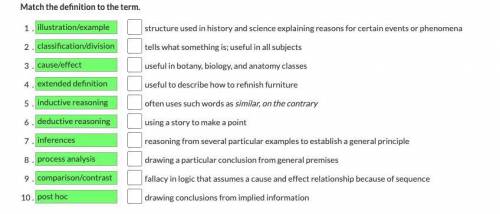
English, 07.10.2020 03:01 mechelllcross
Match the definition to the term.
TERMS
A. illustration/example
B. classification/division
C. cause/effect
D. extended definition
E. inductive reasoning
F. deductive reasoning
G. inferences
H. process analysis
I. comparison/contrast
J. post hoc
DEFINITIONS
1. structure used in history and science explaining reasons for certain events or phenomena
2. tells what something is; useful in all subjects
3. useful in botany, biology, and anatomy classes
4. useful to describe how to refinish furniture
5. often uses such words as similar, on the contrary
6. using a story to make a point
7. reasoning from several particular examples to establish a general principle
8. drawing a particular conclusion from general premises
9. fallacy in logic that assumes a cause and effect relationship because of sequence
10. drawing conclusions from implied information


Answers: 3


Another question on English

English, 21.06.2019 21:20
Read the sentences below and complete the instruction that follows. the coach, who has ten years' experience, has agreed to lead our team. the coach who has ten years' experience has agreed to lead our team. select the answer that explains the difference between the two sentences, as well as the purpose each clause serves for the benefit of the reader. a.) the first sentence contains a noun clause that functions as a predicate nominative; therefore, it renames the subject of the sentence for the reader. the second sentence contains an essential adjective clause that modifies the noun "coach"; therefore, it clarifies for the reader which coach is being discussed. b.) the first sentence contains a nonessential adjective clause that modifies the noun "coach"; therefore, it provides the reader with interesting details about the subject of the sentence. the second sentence contains an essential adjective clause that modifies the noun "coach"; therefore, it clarifies for the reader which coach is being discussed. c.) the first sentence contains a nonessential adjective clause that modifies the noun "coach"; therefore, it provides the reader with interesting details about the subject of the sentence. the second sentence contains a noun clause that functions as a predicate nominative; therefore, it renames the subject of the sentence for the reader. d.) the first sentence contains an adverb clause that modifies the verb "agreed"; therefore, it provides the reader with the answer to the question "when." the second sentence contains an essential adjective clause that modifies the noun "coach"; therefore, it clarifies for the reader which coach is being discussed.
Answers: 1

English, 22.06.2019 02:00
During the medieval period wich group played an important role in staging
Answers: 1

English, 22.06.2019 05:30
Drag each excerpt to its poetic structure. what poetic structures are evident in these poetry excerpts blank verse ballad stanza something there is that doesnt love a wall
Answers: 1

English, 22.06.2019 08:00
Read this passage from the online article “top 10 reasons why everyone is doing yoga” by kathryn livingston. what type of propaganda is the author using? why are so many people doing yoga these days? there must be more to it than endorphins; there has to be a deeper reason why 20 million plus americans have fallen in love with this venerable practice. here is my top ten list – and if you’re a yogi, i’m sure you can think of more.
Answers: 1
You know the right answer?
Match the definition to the term.
TERMS
A. illustration/example
B. classific...
A. illustration/example
B. classific...
Questions





English, 07.09.2020 02:01



Mathematics, 07.09.2020 02:01

Mathematics, 07.09.2020 02:01



Mathematics, 07.09.2020 02:01

English, 07.09.2020 02:01

Chemistry, 07.09.2020 02:01

Mathematics, 07.09.2020 02:01

Mathematics, 07.09.2020 02:01




Mathematics, 07.09.2020 02:01



